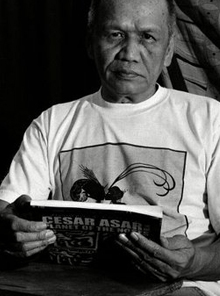This article has multiple issues. Please help improve it or discuss these issues on the talk page . (Learn how and when to remove these messages) |
Roxlee | |
|---|---|
 | |
| Born | Roque Lee August 16, 1950 |
| Nationality | Filipino |
| Alma mater | Naga Elementary School, Ateneo de Naga University, National University, Mowelfund Film Institute |
| Occupation(s) | Experimental Filmmaker and animator, cartoonist, painter, musician [1] |
| Organization(s) | Animagination, Sinekalye, Baybayin Prod. |
| Notable work | Green Rocking Chair (2006), Juan Baybayin (2007), and Manila Scream (2016) |
Roque Federizon Lee (Roxlee) is a Filipino animator, filmmaker, cartoonist, and painter. [1] Considered by many to be the godfather of young Filipino filmmakers, Roxlee is best known for creating Cesar Asar with his brother, Monlee.[ citation needed ]